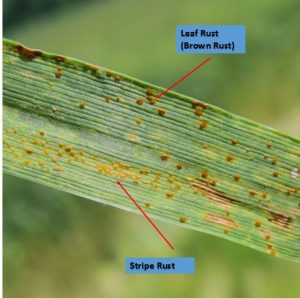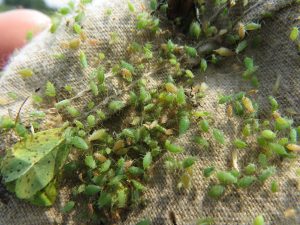NYS IPM Weekly Field Crops Pest Report, June 25, 2018
View from the Field
Potato leafhopper (Empoasca fabae)
Potato leafhopper remain at low levels in alfalfa across the state. Potato leafhopper populations can increase quickly when conditions are right. Remember to scout alfalfa every week to 10 days to monitor potato leafhopper populations.
Here is the link to a video on how to scout for PLH: https://www.youtube.com/watch?v=8BIZYTq7Zec&t=1s
Soybean Aphid (Aphis glycines)
Kevin Ganoe (CCE Field Crops Specialist Central NY) reports finding the 1st soybean aphids of the year. Soybean aphid is the only aphid that will feed on soybeans. This pale yellow-green aphid is small at about 1/16 of an inch. It also has black cornicles, aka “tail pipes” on the posterior end of the insect.
As the summer, moves along we will discuss more detail about IPM for soybean aphids. We have an online course on soybean aphid IPM at: https://pmepcourses.cce.cornell.edu/product?catalog=1401370478 You can earn you 1 recertification credit for New York State DEC certified pesticide applicators in categories 1a, 10, 21, 23.
True armyworm (Pseudaletia unipuncta)
Jodi Lynn Letham (CCE NW NY Dairy and Field Crops Team) reports true armyworm in field corn. The armyworms moved from a hay field into the cornfield and were at high populations. She also reports that alfalfa weevil caused a lot of damage in regrowth alfalfa.
Rusts on Small Grains
Jeff Miller (CCE Oneida County) reports finding stripe rust on small grains like wheat, malting barley, oats, triticale and rye. Stripe rust has also been found on wheat in Monroe and Seneca County. We have also found leaf rust in other parts of the state. The following photo shows the difference between stripe rust and leaf rust on small grains.
Jeff also reported finding scald on malting barley. Depending on the susceptibility of the cultivar, scald can reduce yields. When scald starts to infect the flag leafs it will reduce the plants ability to produce grain and thus yield.
Pea Aphids (Acyrthosiphon pisum)
Mike Stanyard (CCE NW NY Dairy and Field Crops Team) report high levels of pea aphids in alfalfa. Pea aphids are generally not a problem for alfalfa in NY, but at times they can reach high levels. In NY, we have many predators and parasitoids of pea aphids in alfalfa. When an insecticide is used on alfalfa, it eliminates this very important aspect of control pea aphids, other aphids and insect pest in alfalfa. Sometimes when alfalfa is sprayed with an insecticide, you can get a resurgence of pea aphids at higher levels than before the application. The natural enemies have been eliminated and pea aphid and other secondary pest can re-surge.
Field Day Events
Cornell University Willsboro Research Farm Open House: Willsboro, NY – July 10, 2018
The Cornell University Willsboro Research Farm will hold an open house on Tuesday, July 10 from 1:30pm to 4:00pm. A tour of the facilities and research plots will leave the main office (48 Sayward Lane, Willsboro) at 2:00pm. Light refreshments will be provided. Research topics featured at this year’s open house include corn silage variety trials, adaptive nitrogen management for field corn, cover crops, juneberry nursery and production trials, Aronia variety plantings, honeyberry variety trial, high tunnel vegetable production, reduced tillage demonstration plots, season extension for early spring vegetables, organic pepper variety trial, and goldenberry and groundcherry variety evaluations. For more information call 518-963-7492.
2018 Aurora Farm Field Day: Thursday, July 12, 2018 at 9:30am to 3:30pm
Our annual Field Crops field day held at Musgrave Research Farm in Aurora, NY is set for July 12th. The field day is free and open to the public and includes a BBQ lunch.
Skip the registration line by PRE-REGISTERING!
DEC and CCA credits will be available. (DEC: Demonstration – 3.25, Agricultural Plant – 3.25, Field and Forage – 3.25, Vegetable – 1.25)
http://events.cornell.edu/event/2018_aurora_farm_field_day
Weather Outlook – June 21, 2018
Jessica Spaccio
NOAA Northeast Regional Climate Center, Cornell University
Last week temperatures ranged from 2 degrees below normal to 4 degrees above normal. Precipitation has ranged from less than ¼ “ to 3”. Base 50 growing degree-days ranged from 60-140. Abnormally dry conditions have been introduced for many areas in NY.
Dry Thursday and Friday until a frontal system brings rain later Friday through the weekend.
Today will be sunny with temperatures in the 70s and low humidity. Overnight lows will be in the mid 40’s to low 50s.
Friday highs will be in the upper 70s to low 80s; clouds and light rain will spread into in western NY in the afternoon. Overnight temperatures will be in the upper 50s to low 60s.
Saturday temperatures will be in the mid 60s and 70s with showers likely and some thunderstorms possible. Overnight temperatures will be in the upper 50s to mid 60s.
Sunday shower continue, but will be more scattered. Highs will be in the 70s. Overnight temperatures will be in the 50s.
Monday highs will be in the 80s with dry weather for most areas, northern NY may see some lingering showers. Overnight temperatures will be in the upper 40s to mid 50s.
Tuesday will be sunny with highs will be in the mid 70s to low 80s. Overnight temperatures will be in the 50s.
Wednesday highs will be in the 80s. Overnight temperatures will be in the mid 50s to low 60s.
The seven-day precipitation amounts will range from half an inch to 1 ½ inch.
The 8-14 day outlook (June 28-July 4) favors above-normal temperatures for all of the state. The precipitation outlook slightly favors above-normal amounts for all but the northeast corner of the state.
National Weather Service watch/warnings map
Degree Day Models for Field Crops across New York
New York Field Crop Pest Degree Day Accumulations for selected locations
(June 18, 2018)
| Station Location |
GDDs (Base 50 F) March 1 |
Black Cutworm (Base 50) April 24 |
| Ceres | 757 | 744 |
| Chazy | 607 | 607 |
| Geneva | 810 | 809 |
| Highland | 942 | 931 |
| Ithaca | 786 | 785 |
| Massena | 656 | 656 |
| Northport (Richters) | 876 | 857 |
| Valatie | 800 | 795 |
| Versailles | 828 | 821 |
| Watertown | 614 | 614 |
Black Cutworm Degree Day Model
Degree Days Stage Feeding Activity
0 Moth Capture Egg Laying
90 Eggs Hatch
91-311 1st to 3rd Instar Leaf Feeding
312-364 4th Instar Cutting Begins
365-430 5th Instar Cutting Begins
431-640 6th Instar Cutting Slows
641-989 Pupa No feeding
Source: University of Minnesota Black Cutworm Trapping Network
Clipboard Checklist
Keith Waldron, NYS IPM
General
*Walk fields to check general field condition, weed issues
*Watch for crop maturity, stand assessments, weed escapes, nutrient deficiencies, lodging issues
Alfalfa:
*Evaluate established legume stands for approximate days until harvest
*Monitor potato leafhopper, foliar, systemic and crown rot diseases.
*Monitor new seedings for potato leafhopper, pythium blight, phytopthora root rot.
Small Grains:
*Monitor small grains for signs of Fusarium Head Blight, foliar diseases
*Monitor grain fields for growth stage, disease issues, grain maturity, harvest timing
*Record diseases present, location and types of weed escapes
Corn:
*Monitor for mid-season corn pests including European corn borer, corn rootworm, western bean cutworm, slugs, foliar diseases such as northern corn leaf blight and gray leaf spot, weed issues, nutrient deficiencies, vertebrate damage.
Soybeans:
*Monitor for crop growth stage, soybean aphid, defoliators, foliar diseases, white mold, weed issues, vertebrate damage
Pastures:
*Check water sources, mend fences as needed.
*Check crop growth, clip pastures between grazing as needed
*Monitor for invasive species, plants harmful to livestock
*Review/Plan rotations
Equipment:
*Carry appropriate / necessary NYS DEC and EPA documents as needed: (pesticide applicators license, pesticide labels, MSDS sheets, etc.)
Storage:
* Check stored grain bins for temperature, moisture and signs of mold and insects. Aerate, core, transfer grain or treat as necessary
* Clean and disinfect empty storage bins in preparation for grain harvest
*Check forage allocation and anticipate feed program adjustments as forages from previous year are used up
*Mow around storage bins and facility to minimize pest hiding places
Dairy Cattle Barn Fly Management:
*Monitor animals and barn area for house fly, stable fly and other pest management needs including presence of rodents and birds.
*Check facilities for favorable fly breeding conditions: (organic matter + moisture): leaks in watering systems, roof gutters for leaks and potential overspill, drainage,
*Sanitation, sanitation, sanitation – clean animal resting areas, feed troughs, minimize source of moist organic matter i.e. fly breeding areas in barn and in adjacent animal loafing yard
* Continue fly monitoring: install “3X5″ index card fly speck monitoring cards throughout barn
*Use, replenish, replace fly management materials: sticky fly tapes/ribbons, insecticide baits, natural enemies (parasitoids), fly population monitoring (3 x 5) spot cards
*Consider purchase and release of Muscidifurax raptor and/or M. raptorellus natural enemies of house and stable fly pupae.
Dairy Cattle on Pasture:
*Monitor animals for presence of face flies, horn flies and stable flies. Action guidelines: face flies (average 10 per animal face), horn flies (average 50 / dairy per animal side, 200 / beef cattle per animal side), stable flies average 10 per animal (all four legs)
*Check feed bunk / water source locations for signs of stable fly breeding (moist undisturbed organic matter – spilled feed, round bales, etc.), minimize source of moist organic matter i.e. fly breeding areas in barn and in adjacent animal exercise yard.
*Check pasture for forage quality / quantity, rotate as appropriate
*Check pasture for vegetation poisonous to livestock
*Consider use of pasture fly traps to help reduce deer, horse and stable fly populations




